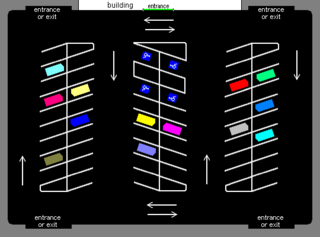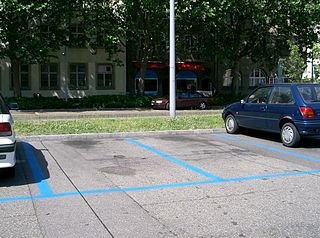This article needs additional citations for verification .(December 2012) |
Double parking refers to parking parallel to a car already parked at the curb or double parking in attended car parks and garages.
This article needs additional citations for verification .(December 2012) |
Double parking refers to parking parallel to a car already parked at the curb or double parking in attended car parks and garages.


"Double parking" means standing or parking a vehicle on the roadway side of a vehicle already stopped, standing or parked at the curb. [1] This often prevents some of the vehicles in the first row from departing and always obstructs a traffic lane or bike lane (to the extent of often making the street impassable in one-way single-lane situations). In some areas, people double parking their cars leave the hand brake off, allowing the drivers of the cars next to the curb to push the double parked car a little forward or backward, in order to allow departing from the parking spot. Double parking in this fashion, where illegal, is often punished by ticketing or towing the offending vehicle.
In some urban areas where parking is extremely hard to obtain, courier and delivery services will instruct their drivers that if necessary they may double park anyway, and if ticketed to simply turn it in at the end of their shift. The practice is so common that Washington, D.C. permits companies to establish a monthly billing account for all of their vehicles that receive any parking tickets. [2]
Attended car parks and garages frequently use double parking to maximize vehicle storage density. A driver who double-parks in an attended car park leaves the vehicle's keys with the attendant. If the driver of the blocked car returns first, then the attendant can move the blocking car so that the blocked car can leave. This practice is especially common for valet car parks, in which attendants have the keys to all vehicles.

Traffic comprises pedestrians, vehicles, ridden or herded animals, trains, and other conveyances that use public ways (roads) for travel and transportation.

Parking is the act of stopping and disengaging a vehicle and leaving it unoccupied. Parking on one or both sides of a road is often permitted, though sometimes with restrictions. Some buildings have parking facilities for use of the buildings' users. Countries and local governments have rules for design and use of parking spaces.

A curb extension is a traffic calming measure which widens the sidewalk for a short distance. This reduces the crossing distance and allows pedestrians and drivers to see each other when parked vehicles would otherwise block visibility.

A parking lot or car park, also known as a car lot, is a cleared area intended for parking vehicles. The term usually refers to an area dedicated only for parking, with a durable or semi-durable surface. In most countries where cars are the dominant mode of transportation, parking lots are a feature of every city and suburban area. Shopping malls, sports stadiums, megachurches and similar venues often have immense parking lots.

In road transport, a lane is part of a roadway that is designated to be used by a single line of vehicles to control and guide drivers and reduce traffic conflicts. Most public roads (highways) have at least two lanes, one for traffic in each direction, separated by lane markings. On multilane roadways and busier two-lane roads, lanes are designated with road surface markings. Major highways often have two multi-lane roadways separated by a median.

Parallel parking is a method of parking a vehicle parallel to the road, in line with other parked vehicles. Parallel parking usually requires initially driving slightly past the parking space, parallel to the parked vehicle in front of that space, keeping a safe distance, then followed by reversing into that space. Subsequent position adjustment may require the use of forward and reverse gears.

Valet parking is a parking service offered by some restaurants, stores, and other businesses. In contrast to "self-parking", where customers find a parking space on their own, customers' vehicles are parked for them by a person called a valet. This service either requires a fee to be paid by the customer or is offered free of charge by the establishment.

A parking space, parking place or parking spot is a location that is designated for parking, either paved or unpaved. It can be in a parking garage, in a parking lot or on a city street. The space may be delineated by road surface markings. The automobile fits inside the space, either by parallel parking, perpendicular parking or angled parking.

A parking enforcement officer (PEO), traffic warden, parking inspector/parking officer, or civil enforcement officer is a member of a traffic control agency, local government, or police force who issues tickets for parking violations. The term parking attendant is sometimes considered a synonym but sometimes used to refer to the different profession of parking lot attendant.

A driveway is a type of private road for local access to one or a small group of structures, and is owned and maintained by an individual or group.

A multistorey car park or parking garage, also called a multistory, parking building, parking structure, parkade, parking ramp, parking deck or indoor parking, is a building designed for car, motorcycle and bicycle parking and where there are a number of floors or levels on which parking takes place. It is essentially an indoor, stacked car park. The first known multistory facility was built in London in 1901, and the first underground parking was built in Barcelona in 1904. The term multistory is almost never used in the US, since parking structures are almost all multiple levels. Parking structures may be heated if they are enclosed.

A pay and display machine is a type of ticket machine used for regulating parking in urban areas or in car parks. It relies on a customer purchasing a ticket from a machine and displaying the ticket on the dashboard, windscreen or passenger window of the vehicle. Details included on a printed ticket are generally the location and operator of the machine, expiry time, fee paid and time entered.

A residential garage is a walled, roofed structure for storing a vehicle or vehicles that may be part of or attached to a home, or a separate outbuilding or shed. Residential garages typically have space for one or two cars, although three-car garages are used. When a garage is attached to a house, the garage typically has an entry door into the house, called the person door or man door, in contrast with the wider and taller door for vehicles, called the garage door, which can be raised to permit the entry and exit of a vehicle and then closed to secure the vehicle. A garage protects a vehicle from precipitation, and, if it is equipped with a locking garage door, it also protects the vehicle(s) from theft and vandalism. Most garages also serve multifunction duty as workshops for a variety of projects, including painting, woodworking, and assembly. Garages also may be used for other purposes as well, such as storage or entertainment.

In road vehicles, the parking brake, also known as a handbrake or emergency brake (e-brake), is a mechanism used to keep the vehicle securely motionless when parked. Parking brakes often consist of a pulling mechanism attached to a cable which is connected to two wheel brakes. In most vehicles, the parking brake operates only on the rear wheels, which have reduced traction while braking. The mechanism may be a hand-operated lever, a straight pull handle located near the steering column, or a foot-operated pedal located with the other pedals.

A parking violation is the act of parking a motor vehicle in a restricted place or in an unauthorized manner. It is against the law virtually everywhere to park a vehicle in the middle of a highway or road; parking on one or both sides of a road, however, is commonly permitted. However, restrictions apply to such parking, and may result in an offense being committed. Such offenses are usually cited by a police officer or other government official in the form of a traffic ticket.
Alternate-side parking is a traffic law that dictates on which side of a street cars can be parked on a given day. The law is intended to promote efficient flow of traffic, as well as to allow street sweepers and snowplows to reach the curb without parked cars impeding their progress. Some proponents also regard the law, which can be quite inconvenient for drivers, as a way to encourage the use of public transportation.

Road signs in Norway are regulated by the Norwegian Public Roads Administration, Statens vegvesen.

A bus garage, also known as a bus depot, bus base or bus barn, is a facility where buses are stored and maintained. In many conurbations, bus garages are on the site of former car barns or tram sheds, where trams (streetcars) were stored, and the operation transferred to buses. In other areas, garages were built to replace horsebus yards or on virgin sites when populations were not as high as now.
Driving etiquette refers to the unwritten or unspoken rules drivers follow. The term dates back to the early 1900's and the use of horse-drawn carriages. Driving etiquette typically involves being courteous and staying alert, which varies by vehicle, situation and location. Failure to adhere to this behavior can cause an increased risk of legal consequences, road collisions, trauma and road rage.

An automated (car) parking system (APS) is a mechanical system designed to minimize the area and/or volume required for parking cars. Like a multi-story parking garage, an APS provides parking for cars on multiple levels stacked vertically to maximize the number of parking spaces while minimizing land usage. The APS, however, utilizes a mechanical system to transport cars to and from parking spaces in order to eliminate much of the space wasted in a multi-story parking garage. While a multi-story parking garage is similar to multiple parking lots stacked vertically, an APS is more similar to an automated storage and retrieval system for cars. The paternoster is an example of one of the earliest and most common types of APS.